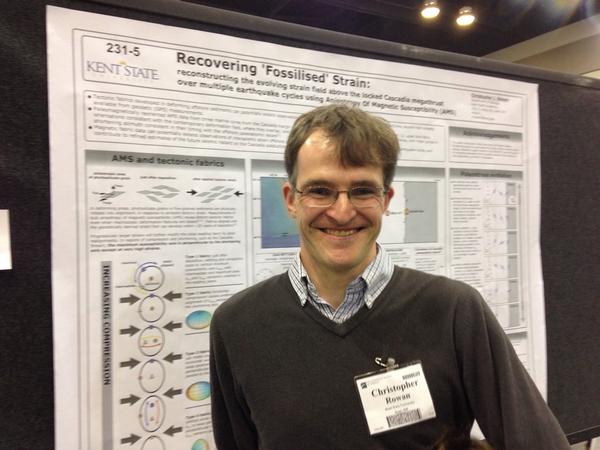For the first time in a while, I attended the Fall Meeting of the American Geophysical Union, to reveal the results of my first foray into education research: The motivation for this study was simple. I had used my sandbox model in my Tectonics and Orogeny class before, and although the students had clearly enjoyed running experiments on it, I wasn’t sure how much they had really learned from it about geological structures and how they develop. There had to be a better way, and…Continue Reading “AGU 2019 Poster: do analogue sandbox models help students to visualise geologic structures and deformation?”
As a follow-up to his presentation at the GSA Northeastern/North-Central meeting in the Spring, KSU undergraduate Joe Wislocki presented more results from analogue modelling of the formation of the Appalachian Pennsylvania salient at the GSA annual meeting in Seattle. ANALOGUE MODELLING OF THE FORMATION OF THE PENNSYLVANIA SALIENT: DO THE APPALACHIANS BEND AROUND AN ANCIENT RIFT? The Pennsylvania salient is an oroclinal bend in the Central Appalachians at around 40ºN, where Appalachian faults and folds are rotated almost 90º clockwise from roughly north-south orientation observed…Continue Reading “Undergraduate research presented at GSA Annual Meeting in Seattle”
A mountain range like the Appalachians is the result of rock along hundreds of kilometres of plate boundary deforming over millions of years. Curiously, if we want to see these processes in action by scaling them down to the dimensions of a tabletop and the timescales of a couple of hours, then the material of choice is sand. Undergraduate Research Assistant Joe Wislocki has been busy the last few months producing mini-mountain ranges in our sandbox model: Joe’s experiments have been focussed on modeling the…Continue Reading “The Appalachians in a sandbox: undergraduate research being presented at GSA North-Central meeting in Pittsburgh”
Last week, I was in Vancouver for the annual meeting of the Geological Society of America. There, I presented the first results of my research into the record of deformation on the Cascadia margin preserved in marine sediment cores. It has long been known that in deforming regions, fine-grained sedimentary rocks often preserve a record of the ambient strain field they formed in. Even very slight deformation causes phyllosilicate grains to rotate into a preferred alignment within the bedding plane, which registers as a slight…Continue Reading “New research on deformation in the Cascadia forearc presented at GSA in Vancouver”
My visit to San Francisco for the American Geophysical Union Fall Meeting was somewhat truncated this year, but I had a stimulating couple of days catching up and talking shop with many friend and colleagues from around the world. I also gave a presentation of new work that follows on from my post-doctoral research under the guidance of David Rowley at the University of Chicago, looking at the evolution of the East Pacific Rise, the world’s fastest spreading oceanic ridge system. Certain aspects of the…Continue Reading “AGU 2013 Presentation: more than slab pull driving the East Pacific Rise?”

